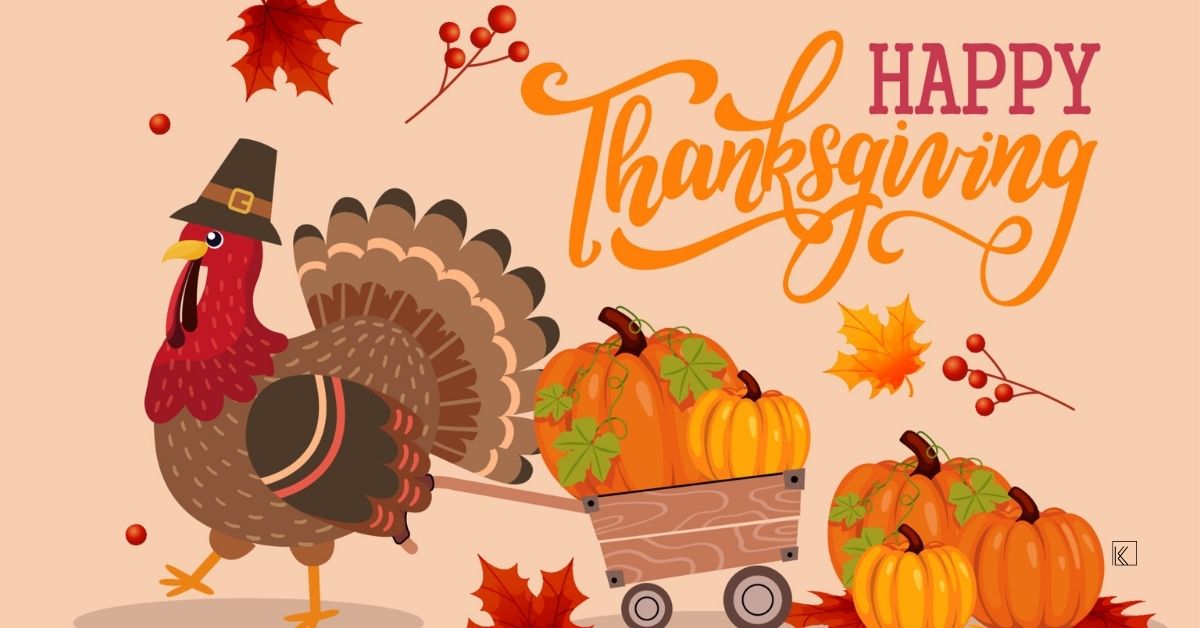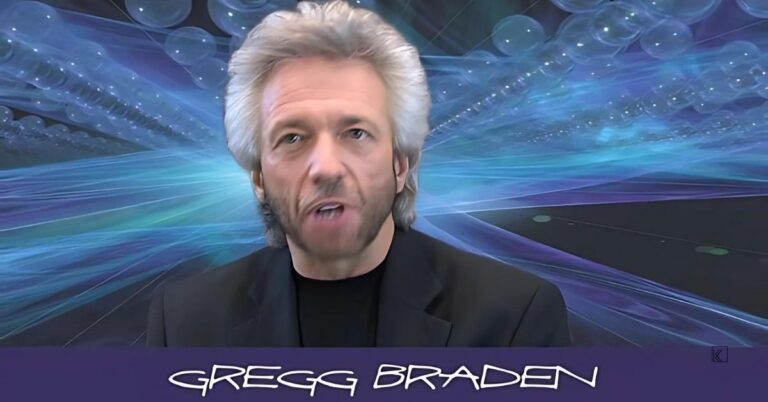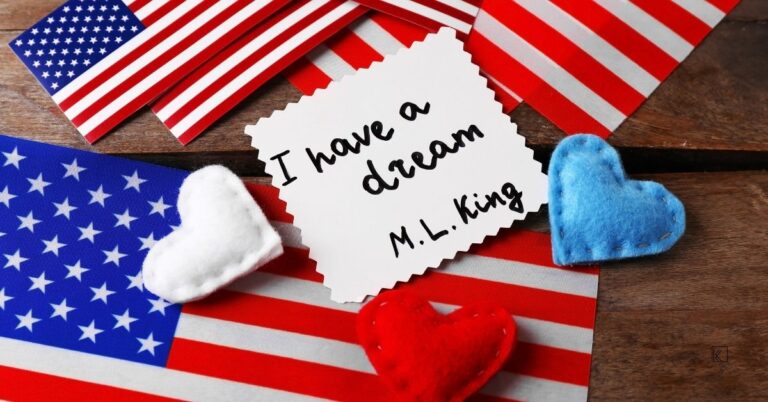Thanksgiving, or Thanksgiving Day, is a holiday celebrated in the United States on the fourth Thursday in November. It has been an annual tradition since 1863, when, during the Civil War, President Abraham Lincoln proclaimed a national day of “Thanksgiving and Praise to our beneficent Father who dwelleth in the Heavens,” to be celebrated on Thursday, November 26.
As a federal and popular holiday in the United States, Thanksgiving is one of the major holidays of the year. Together with Christmas and New Year, Thanksgiving is a part of the broader holiday season.
The First Thanksgiving
The event that Americans commonly call the “First Thanksgiving” was celebrated by the Pilgrims after their first harvest in the New World in 1621. This feast lasted three days and was attended by about 53 Pilgrims and 90 American Indians. The New England colonists were accustomed to regularly celebrating “thanksgivings”—days of prayer thanking God for blessings such as military victory or the end of a drought.
The first documented thanksgiving feasts in territory currently belonging to the United States were conducted by Spaniards in the 16th century.
Thanksgiving services were routine in what was to become the Commonwealth of Virginia as early as 1607, with the first permanent settlement of Jamestown, Virginia, holding a thanksgiving in 1610. On December 4, 1619, 38 English settlers arrived at Berkley Hundred, which comprised about 8,000 acres on the north bank of the James River near Herring Creek, in an area then known as Charles Cittie, about 20 miles upstream from Jamestown, where the first permanent settlement of the Colony of Virginia had been established on May 14, 1607.
Early Thanksgiving Celebrations
The group’s charter required that the day of arrival be observed yearly as a “day of thanksgiving” to God. On that first day, Captain John Woodlief held the service of thanksgiving. As quoted from the section of the Charter of Berkeley Hundred specifying the thanksgiving service:
We ordain that the day of our ship’s arrival at the place assigned for plantation in the land of Virginia shall be yearly and perpetually kept holy as a day of thanksgiving to Almighty God.
Americans commonly trace the Thanksgiving holiday to a 1621 celebration at the Plymouth Plantation, where the Plymouth settlers held a harvest feast after a successful growing season. Autumn or early winter feasts continued sporadically in later years, first as an impromptu religious observance and later as a civil tradition.
Squanto, a Patuxent Native American who resided with the Wampanoag tribe, taught the Pilgrims how to catch eel and grow corn and served as an interpreter for them. Additionally, the Wampanoag leader Massasoit had donated food to the fledgling colony during the first winter when supplies brought from England were insufficient. The Pilgrims celebrated at Plymouth for three days after their first harvest in 1621. Seventeenth-century accounts do not identify this as a Thanksgiving observance; rather, it followed the harvest.
Two colonists gave personal accounts of the 1621 feast in Plymouth, Massachusetts. They began to gather their small harvest and prepare their houses and dwellings against winter, being all well recovered in health and strength and having all things in plenty. Some were employed in affairs abroad, while others exercised in fishing, catching cod, bass, and other fish, which they stored well, and every family had their portion. During the summer, there was no want, and now they began to store up fowl as winter approached, of which this place did abound since they first arrived. Besides fowl, there was a great store of wild turkeys, including venison and much more. Additionally, they had about a peck a meal per person, and since the harvest, Indian corn was added to the proportion.
Subsequent Early Celebrations
The Pilgrims held another Thanksgiving celebration in 1623 after a switch from communal farming to privatized farming; a fast and refreshing 14-day rain resulted in a larger harvest. It has been calculated that this Thanksgiving was made on Wednesday, July 30, 1623, a day prior to the arrival of a supply ship with more colonists but prior to the fall harvest. This thanksgiving was significant to recognize the event as freedom from civil authority, and not from the church, making it likely the first civil recognition of Thanksgiving in New England.
The Massachusetts Bay Colony celebrated Thanksgiving for the first time in 1630 and frequently thereafter until about 1680 when it became an annual festival in that colony.
Presidential Proclamations
On October 3, 1789, President George Washington made the following proclamation and created the first Thanksgiving Day designated by the national government of the United States of America:
Whereas it is the duty of all Nations to acknowledge the providence of Almighty God, to obey his will, to be grateful for his benefits, and humbly to implore his protection and favor, and whereas both Houses of Congress have by their joint Committee requested me “to recommend to the People of the United States a day of public thanksgiving and prayer to be observed by acknowledging with grateful hearts the many signal favors of Almighty God especially by affording them an opportunity peaceably to establish a form of government for their safety and happiness.” Now, therefore, I do recommend and assign Thursday the 26th day of November next to be devoted by the People of these States to the service of that great and glorious Being, who is the beneficent Author of all the good that was, that is, or that will be. That we may then all unite in rendering unto him our sincere and humble thanks for his kind care and protection of the People of this Country previous to their becoming a Nation, for the signal and manifold mercies, and the favorable interpositions of his providence, which we experienced in the course and conclusion of the late war, for the great degree of tranquility, union, and plenty, which we have since enjoyed, for the peaceable and rational manner, in which we have been enabled to establish constitutions of government for our safety and happiness, and particularly the national One now lately instituted, for the civil and religious liberty with which we are blessed; and the means we have of acquiring and diffusing useful knowledge; and in general for all the great and various favors which he hath been pleased to confer upon us. And also that we may then unite in most humbly offering our prayers and supplications to the great Lord and Ruler of Nations and beseech him to pardon our national and other transgressions, to enable us all, whether in public or private stations, to perform our several and relative duties properly and punctually, to render our national government a blessing to all the people, by constantly being a Government of wise, just, and constitutional laws, discreetly and faithfully executed and obeyed, to protect and guide all Sovereigns and Nations (especially such as have shown kindness unto us) and to bless them with good government, peace, and concord. To promote the knowledge and practice of true religion and virtue, and the increase of science among them and Us, and generally to grant unto all Mankind such a degree of temporal prosperity as he alone knows to be best.
Given under my hand at the City of New York the third day of October in the year of our Lord 1789.
Presidents following Washington followed his lead and made proclamations of Thanksgiving, but with no fixed date until, in the middle of the Civil War, President Abraham Lincoln, prompted by a series of editorials written by Sarah Josepha Hale, proclaimed a national Thanksgiving Day to be celebrated on the final Thursday in November 1863. Since 1863, Thanksgiving has been observed annually in the United States.
Changes in the Date of Thanksgiving
In 1939, President Franklin D. Roosevelt broke with this tradition. November had five Thursdays that year (instead of the more common four), and Roosevelt declared the fourth Thursday as Thanksgiving rather than the fifth one. Although many popular histories state otherwise, he made it clear that his plan was to establish the holiday on the next-to-last Thursday in the month instead of the last one.
With the country still in the midst of The Great Depression, Roosevelt thought an earlier Thanksgiving would give merchants a longer period to sell goods before Christmas. Increasing profits and spending during this period, Roosevelt hoped, would help bring the country out of the Depression. At the time, advertising goods for Christmas before Thanksgiving was considered inappropriate.
Regional Traditions and Modern Celebrations
In the 19th century, Thanksgiving traditions in America varied from region to region. A traditional New England Thanksgiving, for example, consisted of a raffle held on Thanksgiving Eve (in which the prizes were mainly geese or turkeys), a shooting match on Thanksgiving morning (in which turkeys and chickens were used as targets), church services, and then the traditional feast, which consisted of some familiar Thanksgiving staples such as turkey and pumpkin pie, and some not-so-familiar dishes such as pigeon pie.
The earliest high school football rivalries took root in the late 19th century in Massachusetts, stemming from games played on Thanksgiving. Professional football took root as a Thanksgiving staple during the sport’s genesis in the 1890s, and the tradition of Thanksgiving football both at the high school and professional levels continues to this day.
Macy’s Thanksgiving Day Parade
One thing that is long associated with Thanksgiving is Macy’s Thanksgiving Day Parade in New York City. The starting point of the parade is Central Park West (near the American Museum of Natural History) and ends at Macy’s flagship store in Herald Square. It is televised by NBC.
The parade features floats and falloons (a combination of balloon and float) with specific themes, scenes from Broadway plays, large balloons of cartoon characters and TV personalities, and high school or college marching bands. The float that traditionally ends the Macy’s Parade is the Santa Claus float, which heralds the arrival of what has become known as the beginning of the Christmas season.
There were many years that I remember my family going into the city to watch the parade live. I remember being in awe of the balloons as well as the floats. Even when I lived in Manhattan years later, on Thanksgiving morning, I always got a good spot at 34th Street and Herald Square to watch the parade and take excellent pictures. To this day, I still love watching it on TV (or, if I am unable to watch it, I tape it to watch later on). All the balloons get blown up the day before the parade, an event not to be missed by young and old. I also remember that when I was 10 years old, my family took a trip to Colonial Williamsburg, had Thanksgiving Dinner at the Williamsburg Inn, and spent time exploring the Colonial Capital.
Presidential Turkey Pardon
The National Turkey Federation has presented the President of the United States with one live turkey and two dressed turkeys in a ceremony known as the National Thanksgiving Turkey Presentation. President Kenney was the first president reported to spare the turkey given to him (“We’ll let this one live“), and President Reagan was the first to grant the turkey a presidential pardon, which he jokingly presented to his 1987 turkey (which would indeed be spared and sent to a petting zoo).
President George H.W. Bush made the turkey pardon a permanent annual tradition upon assuming the presidency in 1989, a tradition that has been carried on by every president each year since. There are legends that state that the “pardoning” tradition dates to President Truman’s administration or even to an anecdote of Abraham Lincoln pardoning his son’s pet turkey. Both stories have been quoted in more recent presidential speeches, but neither has any evidence in the Presidential record.
In more recent years, two turkeys have been pardoned in case the original turkey becomes unavailable for presidential pardoning.
Traditional Thanksgiving Foods and Charity
In the United States, certain kinds of food are traditionally served at Thanksgiving meals. Baked or roasted turkey is usually the featured item on any Thanksgiving feast table (so much so that Thanksgiving is sometimes referred to as “Turkey Day“).
Stuffing, mashed potatoes with gravy, sweet potatoes, cranberry sauce, sweet corn, various fall vegetables (mainly various kinds of squashes), and pumpkin pie are commonly associated with Thanksgiving dinner. All of these are actually native to the Americas or were introduced as a new food source to the Europeans when they arrived. Turkey may be an exception.
The poor are often provided with food at Thanksgiving time. Most communities have annual food drives that collect non-perishable packaged and canned foods, and corporations sponsor charitable distributions of staple foods and Thanksgiving dinners.





